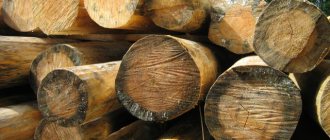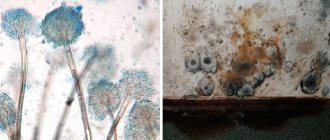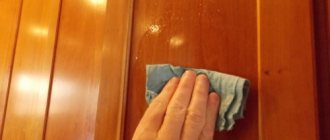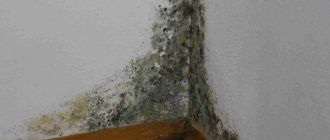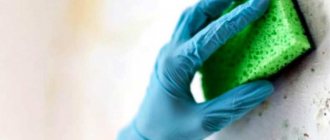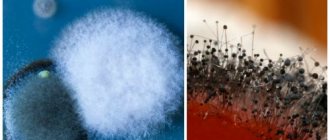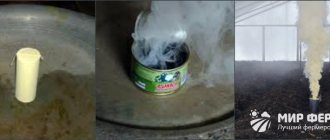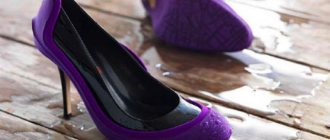Mold spores spoil any surface, worsening its appearance. But they also have a negative impact on human health. Therefore, when signs of fungal development appear, it is necessary to begin an active fight against it. In addition to special means, there are folk remedies that can solve this problem, including copper sulfate. But it is recommended to use it carefully. Therefore, it is worth figuring out how to use copper sulfate against mold.
What is vitriol and how does it happen?
In addition to copper sulfate, there are other types of vitriol. However, copper sulfate is used to eliminate fungal spores. It represents crystalline hydrates of sulfates. Actively involved in medicine, agriculture, and construction. Externally, vitriol resembles small crystals with a blue tint.
Copper sulfate is used to eliminate fungal spores.
What properties does copper sulfate have?
It was noted that copper sulfate is used in medicine, as well as in the agricultural sector. However, it also found use in everyday life. It is often used to remove traces of mold. Suitable even for wood. Copper sulfate can also remove traces of rust. Can be used to prevent the formation of fungus. Among the key properties of the substance are antiseptic.
Copper sulfate can be used to prevent the formation of fungus.
Why coat wood with copper sulfate?
Wood fibers are like a sponge: they can absorb large amounts of moisture from the air or when in direct contact with liquid. The sap is retained in a cut tree, and if it is not dried properly it can rot.
Without additional processing, lumber can deteriorate in a short time, while conventional varnishes and paints only clog the moisture inside, preventing it from evaporating. It is much more effective to apply copper sulfate, a well-known antiseptic, to wood.
Copper sulfate, or copper sulfate, is a salt of sulfuric acid, a bluish, odorless powder. For humans and warm-blooded animals, the toxicity of this substance is moderate, but for bacteria and many insects it is highly toxic. The product has the following properties:
- astringents,
- antiseptic,
- disinfectants.
If you treat a tree with vitriol, it will begin to fight existing problems and will become an excellent preventive measure against wood borers, mold microbes, bacteria, and fungi. The substance does not change the natural shade of the wood, but it stops developing rot. Due to its relative harmlessness, non-flammability, and non-volatility, vitriol can be used in homes and livestock pens.
Also, the advantages of the product include its low cost and availability in stores - it is sold everywhere. The substance also has a downside: it spoils metal, so it is not suitable for wood that already has nails, screws screwed in, or other metal elements.
Causes of mold and mildew on walls
Mold can actively spread over the surface. If the necessary measures are not taken to solve the problem, the health of a person living in such conditions may worsen, even to the development of bronchial asthma. But the fungus does not begin to actively develop in all rooms. Favorable conditions are important for him. One of the common causes of mold development is a humid environment. In rooms with high air humidity, spores multiply more actively, penetrating deeper into the surface layers, reliably attaching themselves there.
A humid environment occurs due to constant temperature changes, regular freezing of the room, and wetness of various surfaces. The lack of a quality ventilation system only exacerbates the problem. Therefore, fungus can appear for the following reasons:
- Severe dampness in the room;
- Lack of good ventilation;
- Some parts of the room are not warm enough.
The apartment can be cozy and warm, but even if at least one corner gets wet or freezes, this is enough for mold to actively spread.
A common cause of mold development is a humid environment.
What can mold cause in your home?
It was noted that the presence of mold can adversely affect health. Spores have a negative effect on the human body for a long time.
Among the common problems that result from constant inhalation of fungus, it is worth noting:
- Development of allergies;
- Decreased general level of immunity;
- Migraine;
- Exacerbation of diseases associated with the lung and bronchial system;
- Development of respiratory diseases.
That is why it is necessary to immediately begin eliminating fungal spores. When primary signs of their presence appear in the house.
The presence of mold can adversely affect your health.
What vitriol should be used against mold and where to get it
Treatment with copper sulfate is usually carried out for mold problems. It is not used in its original form, but after mixing with water, becoming a solution. You can buy crystals in different packaging in stores that sell building materials, household supplies and gardening products.
It is not used in its original form, but after mixing with water, becoming a solution.
Special remedies for fungus
Most manufacturers of building mixtures and paints and varnishes produce various anti-fungal products. It is important to describe the problem to a specialist so that the employee can help you choose a remedy suitable for a specific type of mold. Solutions must match the material to which they will be applied and not spoil it.
The most popular solutions:
- Atlas Mykos - sold in the form of a concentrate, can be used for interior and exterior use, including on mineral surfaces.
- Spectrum - used on wood, putty, painted surfaces, and at high humidity.
- Teflex is an environmentally friendly product that can be applied to walls in a child’s room.
On the walls you can use Antisept, Abedis, Xiolat, Snezhka Impregnation.
Antiseptics in solutions
Typically, solutions are used when the area affected by the fungus is quite large. The drugs are sold in large containers - jars, canisters, and have a ready-to-use form. The concentration of the solutions is safe for humans.
They are applied with a sponge, erasing most of the mold. Usually 1-2 treatments are enough to get rid of the fungus, but then for prevention you can add the product to the water for cleaning the room.
List of the best solutions with fungicidal additives:
- Dali,
- Fongifluid Alpa,
- Olympus Stop mold,
- Biotol,
- Mavix-Bio.
Primers - antifungal
Primers can be used to carry out treatment even at the stage of construction or repair. Good products are sold in any specialized stores; almost every brand of building materials has them. Excellent quality is observed in the soils Milkill (MilKill), Terragrunt, Kremen, Lakra, Auburn.
Most products have the ability to penetrate deeply into the pores of the base. Anti-mold components are introduced into the smallest crevices of concrete, and other substances fill the pores from the outside. To avoid problems with mold for a long time, it is better to treat any surfaces during repairs with similar soils.
Advantages and Disadvantages Compared to Other Mold Remedies
This remedy has been used for many years to eliminate fungal spores. This popularity is associated with a number of advantages, including:
- Good efficiency;
- Low cost of the method;
- Variety of product packaging. You can purchase it in a convenient quantity;
- Easy to use;
- Practicality;
- Protection against re-development of fungus.
One of the disadvantages of the product is that it should only be used in untreated cases. Vitriol will not cope with old, deep traces of mold. It is also necessary to use protective equipment when working with this product, otherwise you may get poisoned.
It is imperative to use protective equipment when working with this product, otherwise you may get poisoned.
What surfaces can it be used on?
A feature of the product is its versatility. It is suitable for various surfaces, including wood, concrete, brick, stone. You can also process drywall and gypsum fiber.
Do not use copper sulfate on metal parts or surfaces. This may trigger a chemical reaction.
Do not use copper sulfate on metal parts or surfaces.
Instructions for use
When purchasing copper sulfate, it comes with instructions regarding the nuances of its use. The information should be carefully studied and the recommendations provided should be strictly followed.
To treat with vitriol, you need to prepare a special solution. Use a container made of plastic, glass or ceramics in which you do not plan to cook food later. The solution is diluted in proportions of 1:100, where for 10 liters of water you need to take 100 g of vitriol crystals. If the fungal infection is not initial, but more severe, it is worth preparing a more concentrated product. Then the proportions change and the ratio becomes 3:100.
First, add a little preheated water to the prepared amount of copper sulfate. Mix everything with a spatula and strain. Then add the rest of the liquid.
If the fungal infection is not initial, but more severe, it is worth preparing a more concentrated product.
Preparation of the solution: detailed instructions
Let's look at how to prepare an aqueous composition of copper sulfate using the example of a 1% solution:
- We use non-metallic dishes with a capacity of 12-14 liters.
- Pour 100 g of copper sulfate powder into a bowl.
- Pour in 500 g of hot water, temperature about 50 0C.
- Mix the solution thoroughly with a wooden stick or spatula until dissolved.
- Add 9.5 liters of water at the same temperature. Mix again.
- We filter the solution.
In the future, we use the resulting solution for its intended purpose. To spray plants, we use a sprayer; to treat surfaces, you can limit yourself to a brush or sponge.
What you need to remove mold using vitriol
Before you begin the troubleshooting process, you need to prepare everything you need in advance. This will allow you not to forget anything and approach the matter in a more organized manner.
To deal with mold, you need to prepare the following:
- Ready solution. It is enough to mix all the ingredients in one suitable container. To increase efficiency, it is recommended to add about 200 ml of vinegar per 10 liters of water to the finished composition;
- Tools with which the product will be applied to the surface. A spray bottle will do. It is the most convenient for such a process. But you can also use a brush or sponge;
- A spatula and a metal brush, allowing you to clean the affected areas;
- Means for protecting the body. In addition to clothing that covers all parts of the body, you need to equip yourself with gloves and a mask.
When these items are prepared, the process of eliminating the fungus problem begins.
Before you begin the troubleshooting process, you need to prepare everything you need in advance.
Processing order
You should follow the procedure and instructions for use when treating a room with a fungicidal composition:
- Dissolve from 100 to 400 grams of vitriol in 10 liters of warm water, stir until completely dissolved;
- Using a roller or paint brush, or simply a sponge, apply the prepared composition to the entire surface to be treated, then dry;
- Dry for 5-6 hours or with a hair dryer. You can apply the finished mixture using a brush, roller, sponge or spray;
- You can apply up to 5 layers, but after each layer you need to maintain a drying time.
- You can use the treated room no earlier than after 2 days; ventilate well first.
Preparing walls for processing
The fight against fungus begins with surface preparation. This will speed up the process and increase its efficiency. First, you should ensure maximum ventilation in the room. To do this, turn on the hood and open the windows as much as possible. Surfaces affected by spores are freed from covering, wallpaper is removed, paint and plaster are cleaned. If the fungus has managed to penetrate deeply inside, then you should additionally clean the areas with sandpaper.
Treat problem areas with a soap solution and leave to dry completely. This stage should not be neglected, especially if black mold has begun to develop. Finally, you must put on the prepared personal protective equipment.
If the fungus has managed to penetrate deeply inside, then you should additionally clean the areas with sandpaper.
How to get rid of mold on walls?
First of all, to get rid of fungus on the walls, you need to do a thorough cleaning. It is necessary to remove all contaminated areas and, if possible, get rid of finishing materials and furniture that have become infected.
If it is not possible to dispose of items, they must be cleaned as much as possible and treated against mold, otherwise it will grow again after a short time.
To clean the walls, it is better to use a stiff brush, scraper or metal sponge. It is worth remembering that during cleaning, spores are widely scattered through the air, therefore, to prevent them from entering the body, you should wear personal protective equipment when working, such as a respirator, safety glasses and rubber gloves. It is also a good idea to wet the surface to be treated with water or soapy water in advance. This will bind mold and dirt and prevent small dust particles and spores from spreading throughout the room. In addition, this action will significantly speed up and facilitate the cleaning process, as well as increase the effectiveness of treatment with anti-mold preparations, especially if the solution is treated with copper sulfate.
See also: How can I get rid of mold on fabric?
The next step is to apply an antiseptic to the affected surface. It can be either a special fungicidal household chemical for treating various surfaces, or a separate substance with an antibacterial effect.
Bleach and chlorine-containing bleaches, copper sulfate, hydrogen peroxide, ammonia and borax are often used as folk methods for getting rid of this problem.
Antifungal medications can be applied using a spray bottle or a wide paint brush. Processing can also be carried out using a soft roller.
It is advisable to treat with an antiseptic in several layers, allowing each of them to dry completely before subsequent application. This will increase the effectiveness of the product and increase the chances that mold will not form again in the future.
After the solution of copper sulfate against fungus on walls and other surfaces has completely dried, you can begin decorating the room. In this case, a special antiseptic primer and putty, as well as antifungal wallpaper glue, are usually used. By using this, you can enhance the effectiveness of the treatment and increase the chances of completely preventing the problem from returning.
Treatment and application
When the surface is prepared, you should start applying vitriol. If you use a spray bottle, just spray the solution onto the desired area. You can apply the product with a sponge, wetting it in the composition and wiping the desired area. Processing should be plentiful. After 4-5 hours, when the surface has dried, it is worth repeating the procedure. The solution is applied again.
The number of repeated treatments after the composition has dried depends on the degree of fungal development. If there is a lot of mold and it has become embedded in the surface, then you will have to repeat the procedure many times. On average, the number of repeated treatments is reduced to 2-5 pieces.
If the spore damage is serious, then in addition to removing the cladding, you must first completely clean off the plaster. Only after this can you begin to treat the area with the solution.
If you use a spray bottle, just spray the solution onto the desired area.
What can you mix with?
In order to increase the effect, some other ingredients are added to the finished composition. This could be 200 ml of vinegar, which will have a positive effect on the processing result. It is also permissible to mix copper sulfate with a few drops of tea tree oil or a small amount of detergent that contains chlorine.
The connection cannot be made with other substances. An undesirable reaction may occur. Also, the prepared solution can be stored for about 3 months on the shelf. If you place the container in the refrigerator, you can preserve the composition for a year. It is important to ensure that the lid is well closed and the solution is in a place that is difficult to reach for children and animals.
To increase the effect, add 200 ml of vinegar, which will positively affect the result of the treatment.
The use of copper sulfate in gardening against mold
Copper sulfate is used to treat the garden in spring and autumn. This is done while the plants are dormant. In the spring before the buds open. In autumn after leaf fall, around November. Spray the trunks and branches of trees and bushes, water the trunk circles.
The spring composition is made at a weak concentration - 0.005% or 5 g of copper sulfate per 10 liters of water. This will protect the plants from rot and fusarium.
In the summer, a one percent solution of copper sulfate is used to treat plants.
Diseases that copper sulfate helps fight:
- coccomycosis.
- scab.
- anthracnose
- gray rot.
- chlorosis.
They begin to act at the first signs of illness. This allows for more gentle treatment of plants. They process pears, apple trees, stone fruit trees, grapevines, berry bushes, and vegetable crops. As part of the Bordeaux mixture, it destroys late blight.
The use of copper sulfate for spraying rose bushes is possible using a 0.5% solution, and for areas with strawberries a lower concentration is used - 0.25%. To do this, dissolve 25 g of blue salt in 10 liters of water.
Be sure to monitor the concentration of the solution; the maximum content of copper sulfate should be no more than 3%. Otherwise, you may get burnt to the leaves and stems of the plant.
For each adult tree, 10 liters of the composition are used. Tall bushes and low-growing trees must be treated with 2 liters; for other plants, 1.5 liters of the prepared solution will be sufficient. For spraying to be effective, make sure that the disinfectant mixture reaches all parts of the plant, leaves, branches and trunk.
How long does the result last?
The duration of the result depends on many conditions. It is important not only to treat the surface, but also to organize everything in such a way as to prevent the fungus from re-developing. It is necessary to exclude high humidity, lack of ventilation and freezing, wetting of surfaces. Then the result from the process will last a long time. If favorable conditions for the spread of spores reappear, then such treatment will have to be repeated constantly. The result will not be long-term.
It is necessary to exclude high humidity, lack of ventilation and freezing, wetting of surfaces.
The main reasons for the appearance of microorganisms
The cellar is a room that is almost constantly in the dark and damp - these are ideal conditions for the development of unwanted fungus and mold. Microorganism spores spread quickly, affecting more and more areas of the room.
Cellars located in residential buildings pose a particular danger - improper operation can lead to the destruction of the basement floor and the penetration of mold and mildew into the house. The reasons are as follows:
- high humidity;
- lack of sunlight;
- lack of air circulation;
- close location of groundwater;
- poor ventilation;
- insufficient waterproofing.
The release of moisture from stored vegetables is a completely normal process, but as a result, condensation can accumulate on the walls and mold can form. Therefore, periodic treatment of the basement and the use of adsorbents are necessary conditions for proper operation.
Preventive measures
In order for the treatment to give the desired result, preventive measures must be taken. This will reduce the likelihood of the fungus developing again and prolong the positive effect of vitriol.
There are a number of measures that will allow you to forget about the problem of mold spread. Among them:
- Regular ventilation of the room. This applies even to the winter period;
- Providing good ventilation;
- Avoiding hypothermia of walls;
- Make sure that the increase in humidity in the room does not last long;
- Monitoring the condition of plumbing. It must always be in good working order;
- Regular and careful maintenance of the water supply system;
- When carrying out repairs, it is necessary to use materials whose compositions are resistant to moisture. It is also recommended to use antiseptics;
- When arranging furniture, leave a small distance between objects and windy walls. Then the air will circulate without obstacles, freely;
- In rooms with significant levels of humidity, it is worth limiting the number of flowers to a minimum.
If the room has plastic windows, then you should take care of high-quality ventilation. Especially if the cladding is made of tiles or plastic panels.
When arranging furniture, leave a small distance between objects and windy walls.
Precautionary measures
Copper sulfate is toxic and should be handled very carefully:
- Prepare the antifungal mixture immediately before use and use within 10 hours.
- Prepare the mixture and store it not in a metal container. Copper corrodes iron and other metals.
- Toxic fumes of copper sulfate cause poisoning and vomiting, use with caution. Follow safety precautions, wear a respirator or mask on your face. Do not allow the powder to become dusty during work; after finishing the treatment, you must wash your face.
- The powder itself is harmless to dry skin, but it must be washed off. Wear rubber gloves and closed clothing.
- While treating the room with an antibacterial composition, turn on the hood or open the window.
- If you are poisoned by copper salt vapors, consult a doctor immediately.
Dangerous black mold: how to get rid of the uninvited “guest”?
After treating the room with a solution of sulfuric acid salt, do not allow conditions for the reappearance of the fungus. Monitor humidity, air exchange and temperature in the room. Leave gaps between the wall and furniture for air circulation. Monitor the condition of water pipes and plumbing fixtures. Ventilate the apartment regularly. After high-quality treatment of the walls with an antifungal composition and compliance with the above conditions, the re-formation of mold fungi is excluded.
Safety precautions at work
In pursuit of getting rid of a fungal problem, it is important to remember your own safety. Therefore, it is necessary to carefully follow all recommendations so as not to harm the body when treating the affected areas.
Among the basic safety rules it is worth noting:
- Gloves must be worn at the stage of preparing the solution, when the crystals are mixed with water. Not only rubber products are suitable, but also latex ones;
- The airways need protection. A respirator would be ideal. But if you don’t have it at hand, you definitely need to put on a gauze bandage and make an improvised mask from it;
- Eyes also need protection. That’s why it’s worth arming yourself with plastic glasses;
- It is not necessary to use special protective overalls. Regular clothing will do. The main thing is that it tightly covers all areas of the body completely. After use, it must be washed;
- All windows and doors must be opened when working. You should also open the windows and turn on the ventilation;
- Animals must be removed from the room and children taken away.
Following these rules will allow you to avoid poisoning and maximize your health while working.
In pursuit of getting rid of a fungal problem, it is important to remember your own safety.
Is vitriol dangerous, and what are the symptoms of poisoning?
Vitriol is classified as hazard class 3. That is why it is so important to take procedures using it seriously. You should not neglect safety measures. Poisoning may occur. It is important to recognize illness quickly and early. With the negative impact of vitriol on the body, nausea and vomiting occur. The heartbeat quickens, severe weakness appears. Pain in the stomach area may also occur. Pain sensations are affected by the degree of poisoning. It can be mild, aching or sharp and sharp.
The most dangerous symptoms are an allergic reaction and toxic shock. It is important to call for help in time and consult a doctor. Any contact with vitriol should be stopped as soon as the first signs of poisoning appear.
Any contact with vitriol should be stopped as soon as the first signs of poisoning appear.
Copper sulfate has long been used to combat fungal spores. And it has proven its effectiveness. He will not be able to cope with a serious, long-standing fungus alone. But not in severe cases, it is quite suitable for solving the problem. The main thing is to protect the body from the negative effects of the product so that the process is not only effective, but also safe.
Where does mold come from and why it needs to be dealt with
The appearance of mold not only spoils the overall appearance of the walls in the premises, but also negatively affects the health of people who spend a lot of time in them. Mold can cause constant weakness, headaches, and general malaise. It can cause an allergic reaction and provoke an asthma attack. Constant exposure to fungal secretions can lead to various upper respiratory tract diseases.
The main reason for the appearance of this fungus is most often high humidity and ineffective ventilation. Mold spores are found almost everywhere. They move freely through the air, settling on objects. When placed in a favorable environment, they germinate and, growing, form a colony, which we observe in the form of dark spots. It is clear that it is advisable to get rid of this uninvited “tenant” as quickly as possible.
